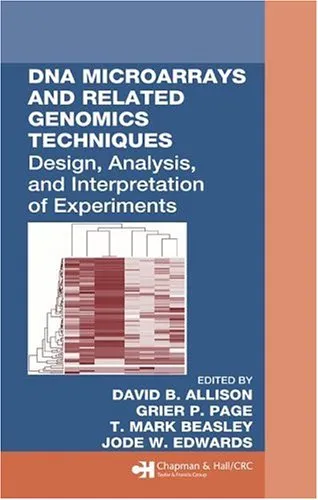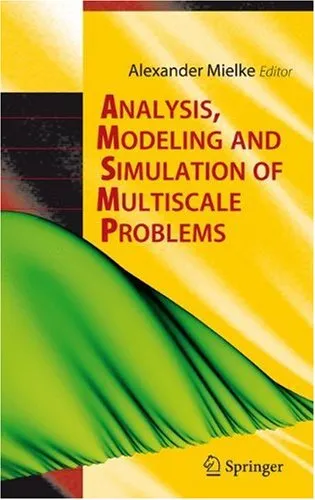DNA Microarrays and Related Genomics Techniques: Design, Analysis, and Interpretation of Experiments (Biostatistics)
5.0
بر اساس نظر کاربران

شما میتونید سوالاتتون در باره کتاب رو از هوش مصنوعیش بعد از ورود بپرسید
هر دانلود یا پرسش از هوش مصنوعی 2 امتیاز لازم دارد، برای بدست آوردن امتیاز رایگان، به صفحه ی راهنمای امتیازات سر بزنید و یک سری کار ارزشمند انجام بدینکتاب های مرتبط:
معرفی کتاب
کتاب DNA Microarrays and Related Genomics Techniques: Design, Analysis, and Interpretation of Experiments (Biostatistics) یکی از مراجع مهم و ارزشمند در حوزه زیستشناسی مولکولی و آمار زیستی است که به طراحی، تحلیل و تفسیر دادههای ژنومی میپردازد. با پیشرفت سریع تکنولوژی در زمینههای Microarray و Genomics، نیاز به درک و تحلیل علمی دقیق این دادهها بیش از پیش احساس میشود. این کتاب توسط گروهی از متخصصان و محققان برجسته شامل دیوید بی. آلیسون، گرایر پی. پیج، تی. مارک بیزلی و جود دبلیو. ادواردز تدوین شده است و برای دانشمندان رشتههای زیستشناسی، آمار زیستی، بیوانفورماتیک و سایر حوزههای مرتبط بسیار ارزشمند است.
خلاصهای از کتاب
کتاب با تکیه بر اصول آماری و ریاضیات پیشرفته، ابتدا به مبانی طراحی آزمایشها در Microarray میپردازد و خوانندگان را با تکنیکهای برتر در زمینه Gene Expression Analysis آشنا میکند. موضوعات کلیدی شامل:
- روشهای طراحی تجربیات Microarray
- تحلیل دادههای Gene Expression
- درک شبکههای ژنی و مکانیزمهای مولکولی
- روشهای مقایسه دادهها با تکنولوژیهای قدیمیتر
- تمرکز بر ابزارهای آماری برای پاکسازی نویز در دادهها
این کتاب به بررسی کاربرد تکنیکهای پیشرفته آماری برای دادههای بزرگ ژنومی، از فیلتر کردن داده تا مدلسازی اطلاعات، پرداخته و بهترین روشها را برای تفسیر دادههای ژنتیکی ارائه میدهد.
نکات کلیدی قابل یادگیری
- چگونه آزمایشهای Microarray خود را بهینهسازی کرده و از آنها بهترین اطلاعات ممکن را استخراج کنیم.
- پیادهسازی تکنیکهای تجزیهوتحلیل دادههای ژنومی با ابزارهای مدرن بیوانفورماتیک.
- فراگیری آماری پیشرفته در زمینه تحلیل دادههای زیستشناسی مولکولی.
- چگونگی شفافسازی دادهها با استفاده از روشهای کاهش نویز.
- درک اهمیت تجزیه شبکههای ژنی و ارتباطات بیولوژیکی.
جملات ماندگار از کتاب
"The power of Microarray technology lies not just in its ability to generate data but in the capacity to turn data into meaningful knowledge."
"To succeed as a scientist in the 'omics' era, it is essential not just to master biology but also the sophisticated statistical tools enabling data analysis."
چرا این کتاب اهمیت دارد؟
پیشرفتهای تکنولوژی در علوم زیستشناسی، مانند DNA Microarrays و سایر تکنیکهای ژنومی، منجر به تولید دادههای بزرگ و پیچیدهای شدهاند که تحلیل صحیح آنها بسیار حیاتی است. این کتاب، ترکیب منحصربهفردی از اصول علمی و تجربه عملی را ارائه میدهد که میتواند به پژوهشگران در درک بهتر این حوزه کمک کند. از دیگر دلایل اهمیت این کتاب میتوان به موارد زیر اشاره کرد:
- راهگشایی برای تحقیقات نوین در زمینه ژنتیک و مولکولی
- ارائه بینشهایی عملی برای پژوهشگران و دانشجویان این حوزه
- پیوستگی مبانی آماری با دادههای واقعی ژنومی
- ایجاد پلی میان علوم زیستی و آمار پیشرفته
این کتاب فراتر از یک منبع تخصصی است و به عنوان راهنمایی جامع برای پیشبرد تحقیقات در علوم 'omics' شناخته میشود.
Introduction to "DNA Microarrays and Related Genomics Techniques: Design, Analysis, and Interpretation of Experiments (Biostatistics)"
"DNA Microarrays and Related Genomics Techniques: Design, Analysis, and Interpretation of Experiments (Biostatistics)" is an essential guide that bridges the powerful worlds of genomics and statistical science. It is crafted to aid researchers, scientists, biostatisticians, and students in understanding how to design, analyze, and interpret experiments involving DNA microarrays and related genomic methodologies. The book is co-edited by a group of distinguished authors, including David B. Allison, Grier P. Page, T. Mark Beasley, and Jode W. Edwards, all renowned experts in their respective fields.
In today’s era of genomics, advancements in DNA microarray and subsequent technologies have revolutionized how we approach the study of gene expression, biomarker discovery, and other critical biological phenomena. However, these technologies often generate complex, high-dimensional data that can be challenging to navigate. This book acts as a comprehensive roadmap, offering both theoretical foundations and practical insights into how to approach genomic experiments statistically and infer robust, reproducible conclusions.
Designed for both novice and experienced researchers, the book elucidates key concepts around genomic data while addressing common pitfalls in experimental design, data preprocessing, and the interpretation of results. With detailed examples, the authors provide clarity on intricate topics, ensuring that readers can conduct reproducible and statistically sound research that withstands rigorous scientific scrutiny.
Detailed Summary of the Book
This book is structured into multiple sections, each dedicated to unraveling core principles of genomic experimentation and the associated analytical techniques. It begins by introducing readers to the fundamental design principles necessary for conducting valid experiments using DNA microarrays and related techniques. The initial chapters provide readers with a firm grasp of the critical role of experimental design in ensuring unbiased, replicable results.
As the book progresses, readers are guided through the statistical methodologies required for preprocessing raw genomic data to eliminate noise and ensure accuracy. Techniques such as normalization, batch correction, and missing data imputation are discussed in detail, enabling readers to clean and prepare their data for meaningful analysis.
Subsequent chapters cover core data analysis techniques, including clustering, classification, and machine learning methods applied within the genomic context. In addition, the book delves into supervised and unsupervised learning approaches, pathway enrichment analysis, and meta-analysis methods for combining datasets from multiple studies. The importance of replicability and avoiding overfitting in genomic research is addressed throughout these sections, emphasizing the critical need for rigor in today’s science.
In the later sections, the book shifts its focus to the interpretation of results and their real-world implications in genomics, such as identifying biomarkers for disease, understanding biological networks, and exploring precision medicine applications. The authors also highlight how genomic data can be integrated with other omics data types, such as proteomics and metabolomics, to gain deeper insights into biological systems.
Key Takeaways
- The importance of robust experimental design in genomic research.
- How to preprocess and clean high-dimensional genomic datasets effectively.
- Core statistical methods for analyzing microarray data, including clustering and classification.
- How to interpret genomic study results and derive actionable biological insights.
- Techniques to integrate genomic data with other biological data types for holistic understanding.
- Guidelines for reproducibility and transparency in genomics research.
Famous Quotes from the Book
"The integrity of genomic research lies not just in the data collected but in the thoughtful design and rigorous analysis that underpin the study."
"Microarrays and modern genomics provide an unprecedented lens into the biological complexity of life. But with this power comes the responsibility to ensure accuracy, reproducibility, and meaningful interpretation."
Why This Book Matters
The relevance of "DNA Microarrays and Related Genomics Techniques" cannot be overstated. As genomics continues to shape the future of healthcare, agriculture, and biotechnology, the need for scientifically robust and statistically sound methodologies has never been greater. This book addresses the gap between understanding complex genomic technologies and applying rigorous statistical methodologies for meaningful insights.
Researchers from diverse fields, including molecular biology, bioinformatics, and statistics, will find this book an indispensable resource. Its detailed explanations on study design, data analysis, and interpretation equip readers with the tools needed to excel in genomic research. Moreover, its emphasis on reproducibility aligns with the growing movement toward open and transparent science.
For educators, this book serves as an excellent teaching resource, offering clear and insightful explanations of foundational and advanced topics in genomic analysis. It empowers students and trainees to think critically and apply their knowledge to solve real-world problems.
In an era of precision medicine and genomics-driven innovation, this book stands as a cornerstone for researchers dedicated to unlocking the mysteries of life through data and science.
دانلود رایگان مستقیم
شما میتونید سوالاتتون در باره کتاب رو از هوش مصنوعیش بعد از ورود بپرسید
دسترسی به کتابها از طریق پلتفرمهای قانونی و کتابخانههای عمومی نه تنها از حقوق نویسندگان و ناشران حمایت میکند، بلکه به پایداری فرهنگ کتابخوانی نیز کمک میرساند. پیش از دانلود، لحظهای به بررسی این گزینهها فکر کنید.
این کتاب رو در پلتفرم های دیگه ببینید
WorldCat به شما کمک میکنه تا کتاب ها رو در کتابخانه های سراسر دنیا پیدا کنید
امتیازها، نظرات تخصصی و صحبت ها درباره کتاب را در Goodreads ببینید
کتابهای کمیاب یا دست دوم را در AbeBooks پیدا کنید و بخرید
1222
بازدید5.0
امتیاز0
نظر98%
رضایتنظرات:
5.0
بر اساس 0 نظر کاربران
Questions & Answers
Ask questions about this book or help others by answering
No questions yet. Be the first to ask!














